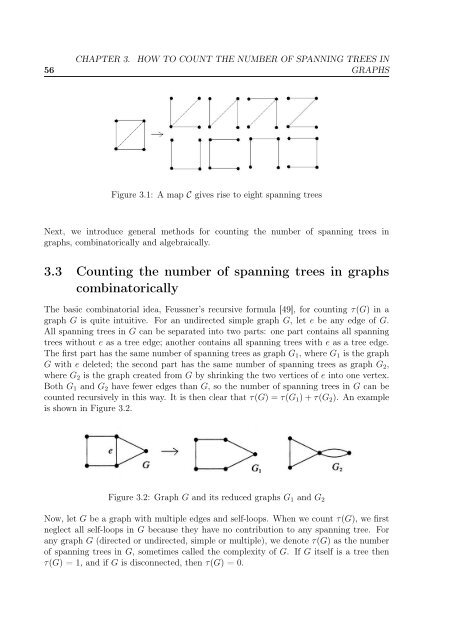enumeration of the number of spanning trees in some ... - Toubkal
enumeration of the number of spanning trees in some ... - Toubkal
enumeration of the number of spanning trees in some ... - Toubkal
Create successful ePaper yourself
Turn your PDF publications into a flip-book with our unique Google optimized e-Paper software.
56CHAPTER 3.HOW TO COUNT THE NUMBER OF SPANNING TREES INGRAPHSFigure 3.1: A map C gives rise to eight <strong>spann<strong>in</strong>g</strong> <strong>trees</strong>Next, we <strong>in</strong>troduce general methods for count<strong>in</strong>g <strong>the</strong> <strong>number</strong> <strong>of</strong> <strong>spann<strong>in</strong>g</strong> <strong>trees</strong> <strong>in</strong>graphs, comb<strong>in</strong>atorically and algebraically.3.3 Count<strong>in</strong>g <strong>the</strong> <strong>number</strong> <strong>of</strong> <strong>spann<strong>in</strong>g</strong> <strong>trees</strong> <strong>in</strong> graphscomb<strong>in</strong>atoricallyThe basic comb<strong>in</strong>atorial idea, Feussner’s recursive formula [49], for count<strong>in</strong>g τ(G) <strong>in</strong> agraph G is quite <strong>in</strong>tuitive. For an undirected simple graph G, let e be any edge <strong>of</strong> G.All <strong>spann<strong>in</strong>g</strong> <strong>trees</strong> <strong>in</strong> G can be separated <strong>in</strong>to two parts: one part conta<strong>in</strong>s all <strong>spann<strong>in</strong>g</strong><strong>trees</strong> without e as a tree edge; ano<strong>the</strong>r conta<strong>in</strong>s all <strong>spann<strong>in</strong>g</strong> <strong>trees</strong> with e as a tree edge.The first part has <strong>the</strong> same <strong>number</strong> <strong>of</strong> <strong>spann<strong>in</strong>g</strong> <strong>trees</strong> as graph G 1 , where G 1 is <strong>the</strong> graphG with e deleted; <strong>the</strong> second part has <strong>the</strong> same <strong>number</strong> <strong>of</strong> <strong>spann<strong>in</strong>g</strong> <strong>trees</strong> as graph G 2 ,where G 2 is <strong>the</strong> graph created from G by shr<strong>in</strong>k<strong>in</strong>g <strong>the</strong> two vertices <strong>of</strong> e <strong>in</strong>to one vertex.Both G 1 and G 2 have fewer edges than G, so <strong>the</strong> <strong>number</strong> <strong>of</strong> <strong>spann<strong>in</strong>g</strong> <strong>trees</strong> <strong>in</strong> G can becounted recursively <strong>in</strong> this way. It is <strong>the</strong>n clear that τ(G) = τ(G 1 ) + τ(G 2 ). An exampleis shown <strong>in</strong> Figure 3.2.Figure 3.2: Graph G and its reduced graphs G 1 and G 2Now, let G be a graph with multiple edges and self-loops. When we count τ(G), we firstneglect all self-loops <strong>in</strong> G because <strong>the</strong>y have no contribution to any <strong>spann<strong>in</strong>g</strong> tree. Forany graph G (directed or undirected, simple or multiple), we denote τ(G) as <strong>the</strong> <strong>number</strong><strong>of</strong> <strong>spann<strong>in</strong>g</strong> <strong>trees</strong> <strong>in</strong> G, <strong>some</strong>times called <strong>the</strong> complexity <strong>of</strong> G. If G itself is a tree <strong>the</strong>nτ(G) = 1, and if G is disconnected, <strong>the</strong>n τ(G) = 0.

















